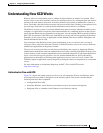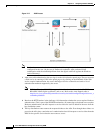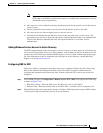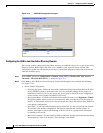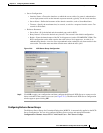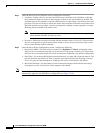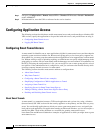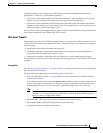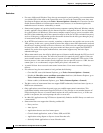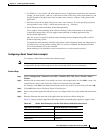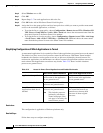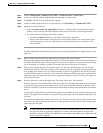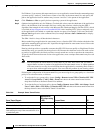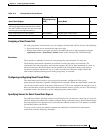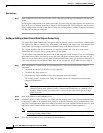
72-43
Cisco ASA 5500 Series Configuration Guide using ASDM
Chapter 72 Configuring Clientless SSL VPN
Configuring Application Access
Configuring smart tunnels requires one of the following procedures, depending on whether the
application is a client or is a web-enabled application:
• Create one or more smart tunnel lists of the client applications, then assign the list to the group
policies or local user policies for whom you want to provide smart tunnel access.
• Create one or more bookmark list entries that specify the URLs of the web-enabled applications
eligible for smart tunnel access, then assign the list to the group policies or local user policies for
whom you want to provide smart tunnel access.
You can also list web-enabled applications for which to automate the submission of login credentials in
smart tunnel connections over clientless SSL VPN sessions.
Why Smart Tunnels?
Smart tunnel access lets a client TCP-based application use a browser-based VPN connection to access
a service. It offers the following advantages to users, compared to plug-ins and the legacy technology,
port forwarding:
• Smart tunnel offers better performance than plug-ins.
• Unlike port forwarding, smart tunnel simplifies the user experience by not requiring the user
connection of the local application to the local port.
• Unlike port forwarding, smart tunnel does not require users to have administrator privileges.
The advantage of a plug-in is that it does not require the client application to be installed on the remote
computer.
Prerequisites
See the Supported VPN Platforms, Cisco ASA 5500 Series for the platforms and browsers supported by
ASA Release 8.4 smart tunnels.
The following requirements apply to smart tunnel access on Windows:
• ActiveX or Sun JRE 5, Update 1.5 or later (JRE 6 or later recommended) on Windows must be
enabled on the browser.
ActiveX pages require that you enter the activex-relay command on the associated group policy. If
you do so or assign a smart tunnel list to the policy, and the browser proxy exception list on the
endpoint specifies a proxy, the user must add a “shutdown.webvpn.relay.” entry to this list.
Note Browser-based VPN access does not support Windows Shares (CIFS) Web Folders on
Windows 7, Vista, Internet Explorer 8, Mac OS, and Linux. Windows XP SP2 requires a
Microsoft hotfix to support Web Folders.
• Only Winsock 2, TCP-based applications are eligible for smart tunnel access.
• Smart tunnel supports Mac OS running on an Intel processor only.
• Java Web Start must be enabled on the browser.



